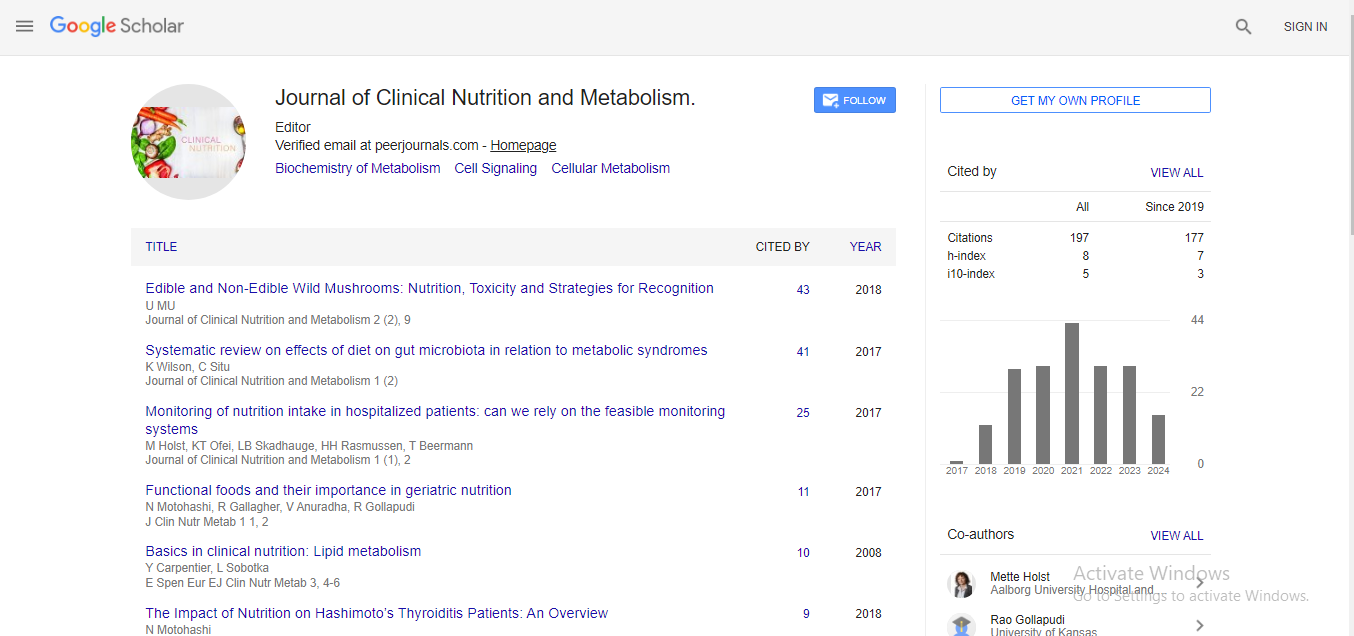Annual Meeting Abstract, J Clin Nutr Metab Vol: 4 Issue: 3
Protective effects and mechanisms of Alaska pollock skin derived collagen peptides on intestinal mucosal barrier function- Qianru Chen- Ocean University of China
Qianru Chen Ocean University of China, P R China
Keywords: skin, Collagen
Intestine, a tightly regulated barrier answerable for nutrients absorption and defense in opposition to noxious molecular and organisms, has been identified as a key component involved within the pathogenesis of meals allergy, infection bowel disorder, celiac sickness and improvement of immune and organ dysfunction after burn and critical illness. Thus, the protection of intestinal barrier feature is regard as a pivotal goal for fitness and enhance the analysis of critically unwell patients. Collagen peptides (CPs) were proven to have broad spectra of physiologic and pharmacological homes and showed as a safe nutritional complement for the development of practical meals by many international organizations. Purpose: The motive of this observe is to analyze the protective outcomes of CPs on intestinal barrier feature in vitro and in vivo. Findings: Collagen peptides derived from Alaska pollock skin may want to attenuate TNF-? caused barrier disorder of Caco-2 cells and burn caused intestinal barrier disruption of mice through inhibiting the NF?B and MAPKs-mediated MLCK pathway with associated reorganization and reduces of tight junction protein ZO-1 and occludin. Conclusion & Significance: This first observes that the protective effect of Alaska pollock pores and skin derived collagen peptides on the role and structure of intestinal mucosal barriers has been extensively studied and elucidated. It not best gives a theoretical basia for the improvement of CPs supplemented purposeful foods, however also offers a new method for the patients affected by intestinal barrier disorder. The intestine is a specialized organ wherein dynamic interactions between host cells and the complex surroundings occur further to food digestion and absorption. As the first bodily barrier, the intestinal epithelial cell layer performs a important role in in opposition to external elements and retaining intestinal homeostasis, collectively with the commensal bacteria, the chemical barrier of the mucosal layer, and the cell immune system. The term “intestinal epithelial barrier feature (IEBF)” is used here to consult the capability of intestinal epithelial cells as a defensive barrier that restriction noxious molecules permeation form intestinal lumen to the underlying tissues, even as supporting vitamins and water transport. Compromised IEBF has been associated with some of pathological conditions, both intestinal and systemic, inclusive of inflammatory bowel diseases (IBDs), metabolic disorders, systemic inflammatory reaction syndrome (SIRS), etc. IEBF may consequently be a prognostic marker for disease pathophysiology; similarly, concentrated on the IEBF holds promise for therapy and for the prevention of diseases. According to previous studies, TNF-α stimulated Caco-2 mobile monolayers became hired in this study as an intestinal epithelial barrier dysfunction model. Trans-epithelial electrical resistance (TEER) and 4 kDa fluorescein isothiocyanate-conjugated dextran (4 kDa FITCdextran, FD-four) permeability are two not unusual parameters to signify the integrity and permeability of cell monolayers, which may be used to appraise the protective effect of collagen peptides on IBEF. TEER is indicative of the ionic conductance of the paracellular channel in the epithelial monolayer and FD-4 permeability displays the paracellular permeability to nonionic macromolecules and indicates the pore length of the tight junctions. Alaska pollock skin (APS)-derived collagen turned into hydrolyzed with the aid of trypsin and sequentially separated into 4 fractions: M1 (MW > 1500 Da), M2 (one thousand Da < MW> 0.05). Similarly, as shown, all fractions of collagen peptide showed an apparent inhibition of FD-4 increased permeability by 52.3–87.1 percent compared to the TNF-α group (p0.05).Taken together, the relative plentiful collagen peptide fraction M3 behaved great in protecting Caco2 cells barrier function and, thus, was decided on for the subsequent step.
 Spanish
Spanish  Chinese
Chinese  Russian
Russian  German
German  French
French  Japanese
Japanese  Portuguese
Portuguese  Hindi
Hindi 